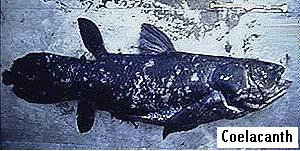

In 1812 a Paleontologist named George Cuvier said, "There is little hope of discovering new species of large quadrupeds" - A quadruped is an animal that walks on four feet
It was Mary Mantell that would disprove this statement in 1822 when she found the first dinosaur tooth later known as Iguanodon.
Since then thousands of unknown animals have been found.
Many, which were thought to have been extinct but are now known to be alive are known as "living fossils"
A living Fossil is an animal that was once known only by its fossilized bones. They were believed to have been extinct for millions of years. But then, to the astonishment of many, these animals were later found to be alive in remote parts of the world.
The term "Living Fossil" was used to describe any creature that fit into this group.
The sad thing is many of these animals had previously been used as "proof" of evolution. How many people believed something that was not true, based on these fossils?

 |
One of my favorite "living fossils" is the Okapi.
The okapi was once thought to have been extinct until they were found still living. These animals were once used as evidence that the horse had evolved. |

|
The Coelacanth
"The original discovery of the Coelacanth in 1938 is still considered to be the zoological find of the century. This 'living fossil' comes from a lineage of fishes that was thought to have been extinct since the time of the dinosaurs. The Coelacanth (see-lah-kanth) is a fish caught in South Africa in 1939 off the coast of Madagascar. Recently coelacanths have also been found in Indonesia. These fish were thought to have been extinct for 70 million years. ( they think dinosaurs died out 65 million years ago !) In the 70 million years that it is said to have been extinct, it has not changed or evolved at all ! The coelacanth was what they call an "index fossil". This means that whenever they found fossils of other animals in the same layer as the coelacanth, they "automatically knew" that it too was 70 million years old. Because it is still alive today, it's fossils could be found in any layer of rock (of any age). |
| - | In Wollemi National Park (in the Blue Mountains) the New South Wales National Parks and Wildlife Services has found a pine tree once thought to be extinct. They are close relations to plants only found in the so called "Jurassic and Cretaceous" periods. (65-200 million yrs ago). There are very few of these trees left in an isolated area. Field Officer David Noble found them in 1994. |
There are many more of these "extinct" animals being found alive and unchanged all the time.
Some animals to be included and discussed are:
Limulus polyphemus *the horseshoe crab
The tuatara, the cycad, the ginkgo, Ginkgo bilob,

Cryptozoology is the study of these "hidden" animals.
"Many animals which are well-known and accepted were once controversial--or at least "unexpected." Some of the more interesting of these cryptozoological precedents are:
* The gorilla, largest of all the primates, discovered in Central Africa in 1847;
* Baird’s tapir, discovered in Central America in 1863;
* The giant panda, discovered in China in 1869, but not collected alive until 1936;
* Przewalski’s horse, discovered in Mongolia in 1881;
* The mountain gorilla, a subspecies, discovered in East Africa in 1902;
* The okapi, a fossil giraffid, discovered in Zaire in 1901;
* The pygmy chimpanzee, described in 1929, but not brought back to Europe from Zaire
until the late 1930's;
* The coelacanth, a 6-foot Mesozoic fish (a true "living fossil"), discovered in South Africa
in 1938;
* The Chacoan peccary, a Pleistocene fossil form, discovered alive in Paraguay in 1975;
* Megamouth, a 15-foot shark, representing a completely new species, genus, and family,
discovered in 1976."
Quote from International Society of Cryptozoology Invitation For Membership (source AIG)
If all of these animals have not evolved in 50 million, 100 million or even 200 million years, then why should we believe that they (or anything) have evolved?
Some changes due to speciation have occurred, but not the large scale changes that evolution supposes.
Also it is impossible to see the insides of these fossils, to know what their makeup was. From a creationist viewpoint the animals of the past are more complex than their living relatives. It would be interesting to be able to study these specimens when they were alive.
The entire creation has degenerated as part of the decay process (an effect of Adam's sin). See my commentary on Genesis 3.

If you have any questions on Creation, Evolution, or just want to say "Hi" please feel free to email me.

 | Main Index |
| Main Index | 